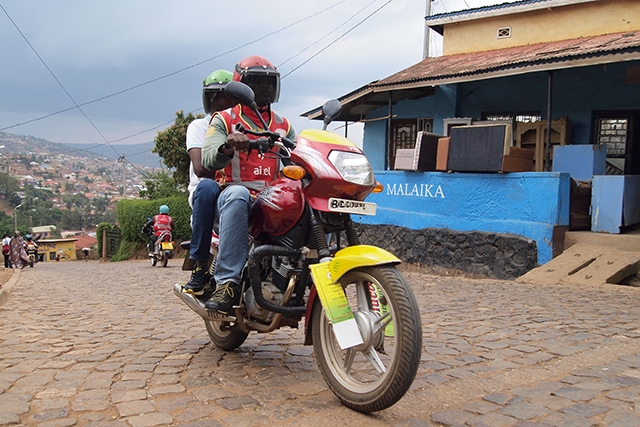News
A motorcycle taxi (called Boda-boda) in Kigali, Rwanda. (Photo by Zenith4237 via Wikimedia Commons)
There are an average of 29.7 road traffic fatalities per 100,000 people in Rwanda, placing it among the most dangerous nations in Africa for motorists.
A group of Harvard John A. Paulson School of Engineering and Applied Sciences students explored strategies to improve road safety in Rwanda as their project in the course “Engineering Problem Solving and Design Project” (ES 96).
ES 96 challenges students to use engineering design skills to create a solution to a problem faced by a real-world client. Dr. Elizabeth Krebs, an assistant professor of Emergency Medicine at Thomas Jefferson University, has collaborated with Rwandan partners in road safety initiatives for many years, and introduced the course faculty to the potential benefits that domestically manufactured motorcycle helmets could bring to Rwanda.
“In Rwanda, lack of good infrastructure leads to poor driving outcomes. . .Poverty is a big driver, but so is people not using helmets properly or using low-quality helmets,” said Cole Dollinger, S.B. ’22, a mechanical engineering concentrator. “This is an incredibly multifaceted issue and there are so many avenues to explore to come up with a solution. . .It doesn’t matter if you have good helmets without educated drivers or enforcement to wear the helmets.”
After studying the problem from multiple angles, the students proposed a three-part solution; they assessed the cost to produce motorcycle helmets in Rwanda, developed a road safety curriculum, and created resources to help the Rwandan government introduce legislation for new vehicle and road regulations.
To determine the feasibility of manufacturing helmets in Rwanda, the students explored fixed and marginal production costs, including warehouse space, personnel, maintenance, and contract components. They hypothesized that it is possible to produce higher-quality, 1.3-kilogram helmets with a thermoplastic polymer shell and expanded polystyrene liner that meet more stringent U.S. safety standards for about $10 each.
They also created a road safety curriculum with content for primary school and high school students, as well as young adults. The team drew on advice from Healthy People Rwanda CEO Dr. Innocent Nzeyimana to develop evidence-based, age-appropriate educational resources.
“The most important elements for making the curriculum successful are making sure that we don't create risk for the people of Rwanda,” said Katie Barkin, S.B. ’22, a mechanical engineering concentrator. “Road safety education done incorrectly can increase confidence without increasing skill, and so actually increase risk. We were very aware of this and so made sure that our topics and methods were created in such a way as to actually help people and decrease risk on the road.”
In addition, the students outlined a 10-year plan for the Rwandan government that focuses on helmet subsidization, helmet quality regulation, and road safety curriculum implementation, with guidance from Francois Zirikana, a senior engineer at the Rwandan Ministry of Infrastructure. The students projected that implementing their proposals could dramatically reduce fatalities and hospitalizations, saving the Rwandan government between $11 and $22 million.
“Reaching out to government officials and understanding what is actually needed and financially/temporally feasible was critical for our group’s success,” said Sarah Goldfarb, S.B. ’22, an engineering sciences concentrator. “Through collaborating with specific individuals in dedicated branches of the government, we hope to increase the likelihood of success for each of our solutions, as we will have dedicated individuals interested in moving forward with our proposals after the semester is concluded.”
Collaboration was critical to the students’ project. The biggest challenge the team faced was a lack of data from Rwanda, which made it difficult to identify the most prevalent problems, said Spencer Rolland, S.B. ’22, a mechanical engineering concentrator. They attempted to overcome this barrier through interviews with experts to help hone their focus.
“One of the most significant lessons I learned during this semester was understanding all the opportunities and problems there are outside the walls of the classroom. So often, students get bogged down on certain problems on problem sets and trying to find the exact, correct answer,” Rolland said. “With ES 96, there is no exact answer to the problem, it is our responsibility as students to come up with the solution but also what we perceive the problem to be.”
Krebs, Nzeyimana, and Zirikana were impressed by the students’ efforts.
“The ES 96 students really did well by producing very rich and comprehensive road safety curriculums,” Nzeyimana said. “Their work is of paramount importance as it will speed our target of having road safety curriculum presented to education policymakers for its incorporation in the formal primary and secondary education systems.”
“Engaging with ES 96 students really helped to catalyze and add structure to our next steps of execution—there are nearly endless aspects to consider in Rwandan helmet manufacturing, and these students were helpful in their presentation of some of those considerations,” Krebs said. “I hope that their more enduring contribution will be an institutional connection between Harvard SEAS and the University of Rwanda College of Science and Technology. There are myriad mutual benefits to each of our respective student and faculty cohorts realized through collaboration, and I am grateful for the opportunity to help facilitate connections where they otherwise may not have materialized.”
Instructor Jeffrey Paten, Lecturer on Engineering Sciences, was pleased by how the students’ overcame the many challenges they faced during the virtual semester.
“COVID has brought about many challenges but has also presented us with new opportunities. Our newfound comfort with completely virtual meetings opened the door for a global partnership,” said Paten. “The challenges faced by the client provided an excellent case study for our ES 96 students to further their complex systems thinking.”
Topics: Academics
Cutting-edge science delivered direct to your inbox.
Join the Harvard SEAS mailing list.
Press Contact
Adam Zewe | 617-496-5878 | azewe@seas.harvard.edu



